Abstract
A study of cancer risk among male employees at 241 livestock feed processing companies in Denmark was conducted on the basis of a data linkage system for detailed investigation of occupational cancer providing employment histories back until 1964, established at the Danish Cancer Registry. Crops imported for feed production have often been contaminated with highly variable concentrations of aflatoxins; an estimated average concentration of at least 140 micrograms aflatoxin B1 kg-1 prepared mixed cattle feed prevailed in the past, yielding a daily intake for workers via the respiratory route of approximately 170 ng. Risk was established on the basis of cancer cases among male workers, whose employment in one of the companies was the job they had held for the longest time since 1964. Elevated risks for liver cancer and for cancers of the biliary tract were observed, which increased by two- to three-fold significance after a 10-year latency. Exposure to aflatoxins in the imported crops was judged to be the most probable explanation for these findings, although the influence of lifestyle factors, e.g. alcohol consumption on the results cannot be fully disregarded. Increased risks for salivary gland tumours and multiple myeloma were also detected. However, due to multiple comparisons carried out in this study these new associations must await further confirmation. A decreased risk for lung cancer was observed; despite possible negative confounding due to the smoking habits of the employees, the lung does not seem to be a target organ for the carcinogenic effect of inhaled aflatoxins in humans.
Full text
PDF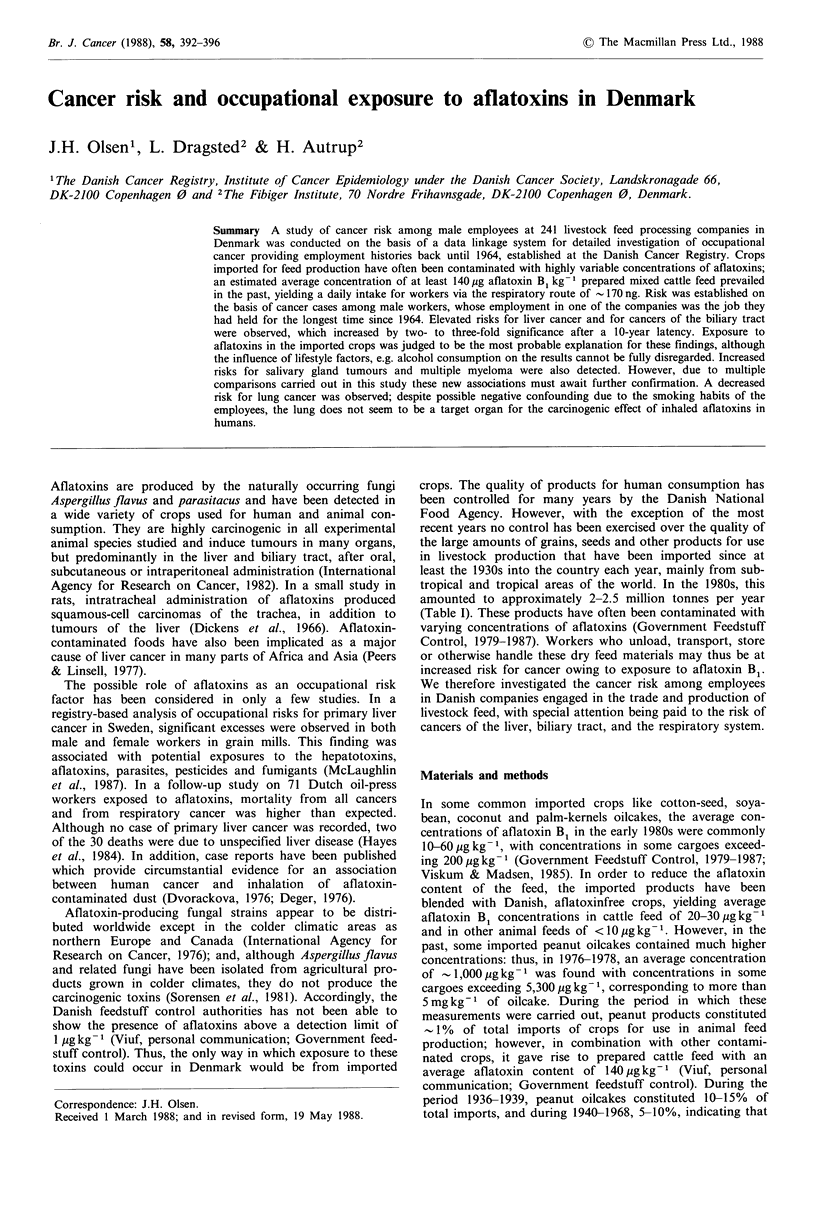
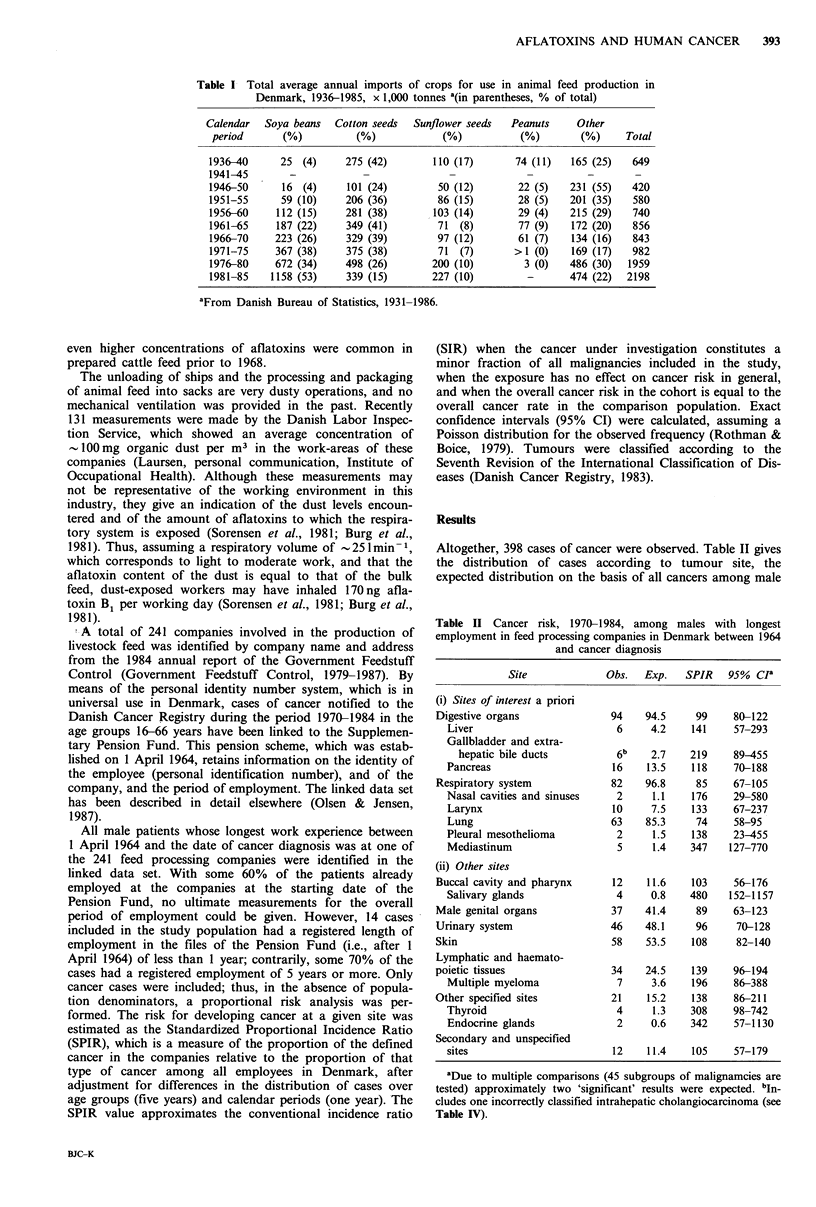
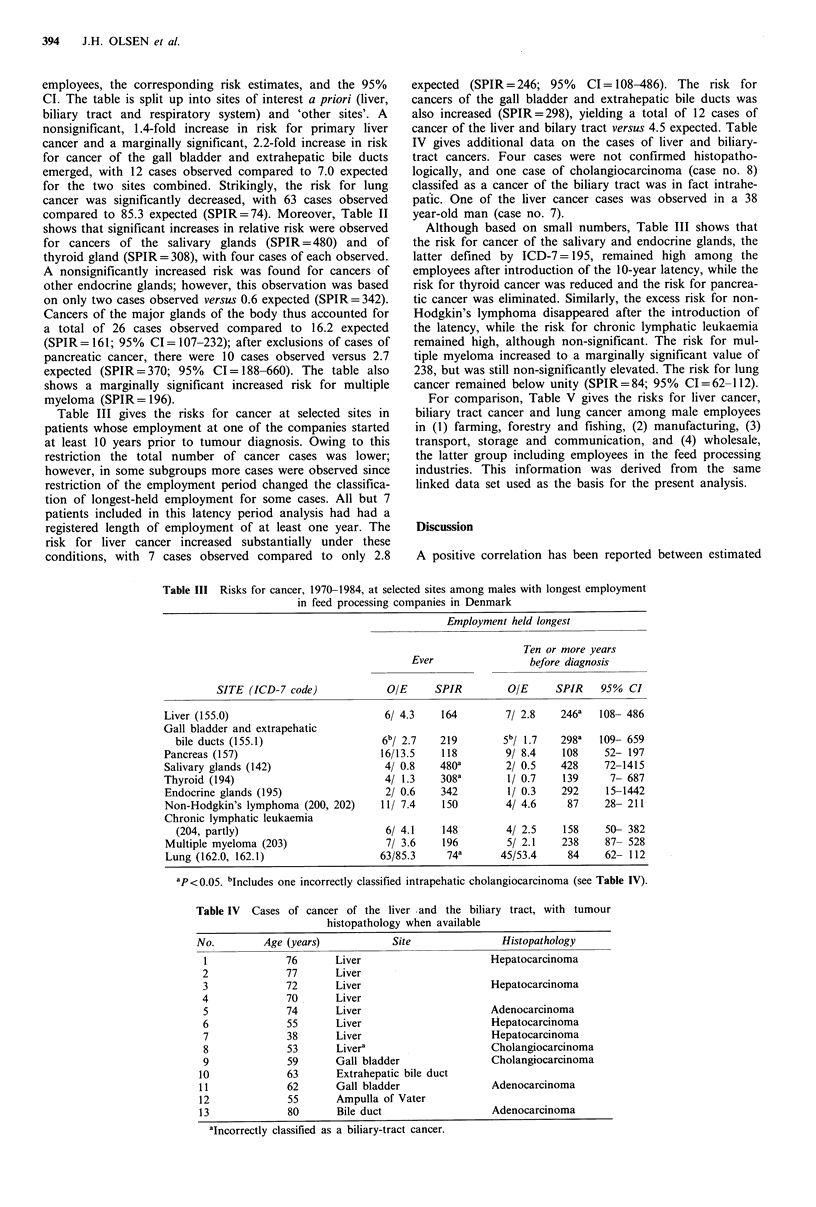
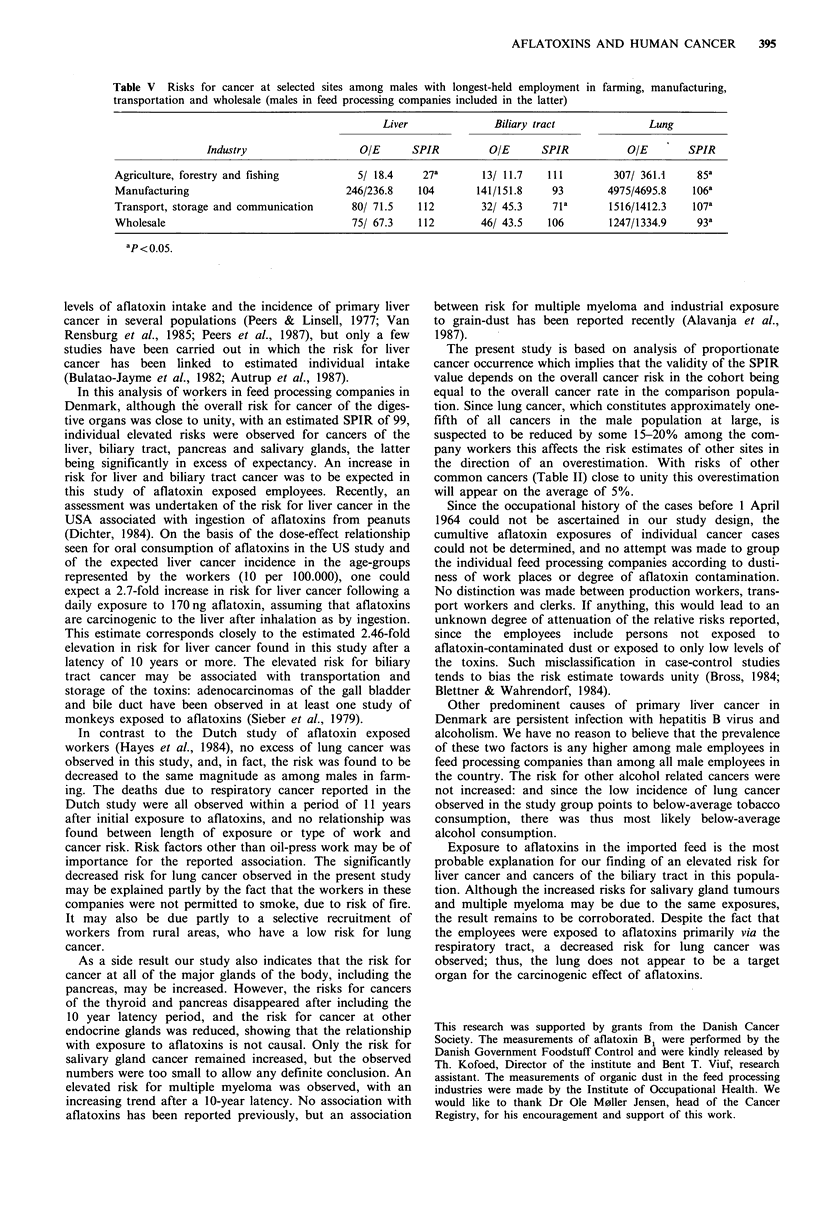
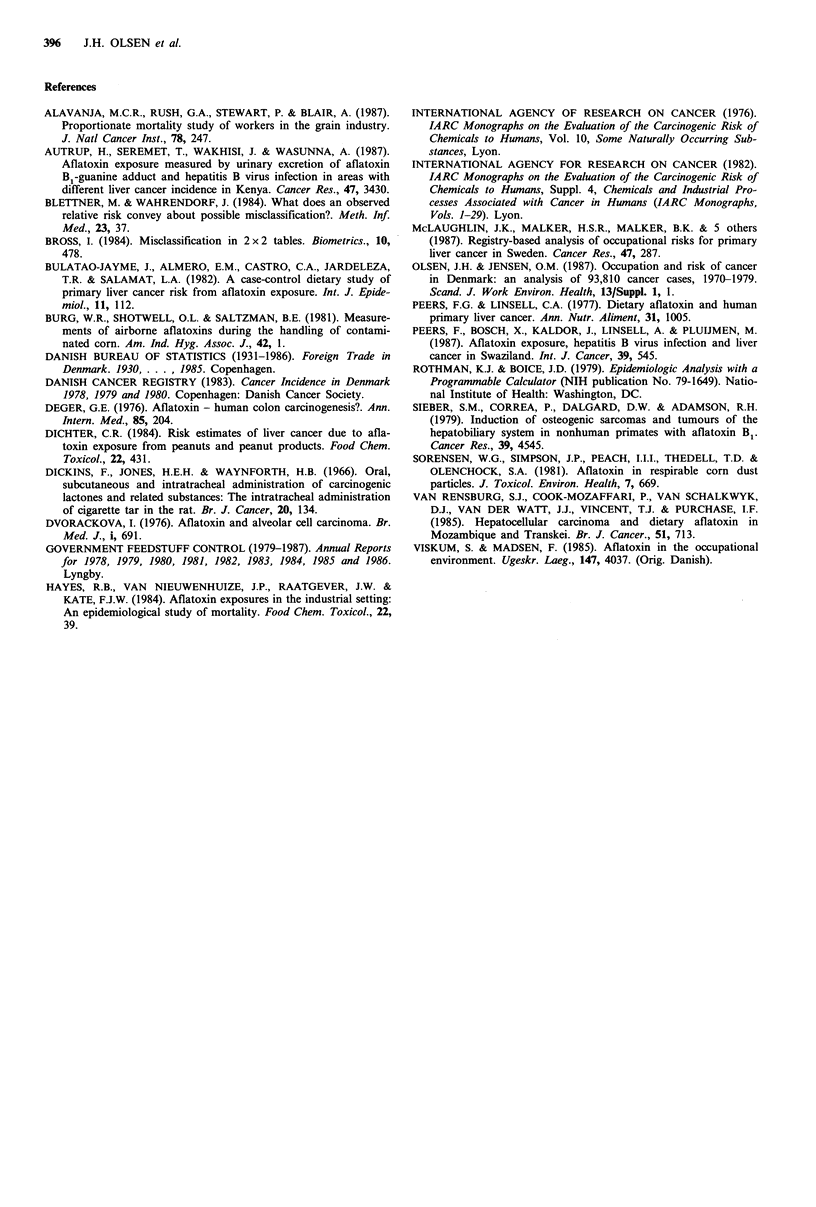
Selected References
These references are in PubMed. This may not be the complete list of references from this article.
- Alavanja M. C., Rush G. A., Stewart P., Blair A. Proportionate mortality study of workers in the grain industry. J Natl Cancer Inst. 1987 Feb;78(2):247–252. [PubMed] [Google Scholar]
- Autrup H., Seremet T., Wakhisi J., Wasunna A. Aflatoxin exposure measured by urinary excretion of aflatoxin B1-guanine adduct and hepatitis B virus infection in areas with different liver cancer incidence in Kenya. Cancer Res. 1987 Jul 1;47(13):3430–3433. [PubMed] [Google Scholar]
- Blettner M., Wahrendorf J. What does an observed relative risk convey about possible misclassification? Methods Inf Med. 1984 Jan;23(1):37–40. [PubMed] [Google Scholar]
- Bulatao-Jayme J., Almero E. M., Castro M. C., Jardeleza M. T., Salamat L. A. A case-control dietary study of primary liver cancer risk from aflatoxin exposure. Int J Epidemiol. 1982 Jun;11(2):112–119. doi: 10.1093/ije/11.2.112. [DOI] [PubMed] [Google Scholar]
- Burg W. A., Shotwell O. L., Saltzman B. E. Measurements of airborne aflatoxins during the handling of contaminated corn. Am Ind Hyg Assoc J. 1981 Jan;42(1):1–11. doi: 10.1080/15298668191419271. [DOI] [PubMed] [Google Scholar]
- Deger G. E. Letter: Aflatoxin--human colon carcinogenesis? Ann Intern Med. 1976 Aug;85(2):204–205. doi: 10.7326/0003-4819-85-2-204. [DOI] [PubMed] [Google Scholar]
- Dichter C. R. Risk estimates of liver cancer due to aflatoxin exposure from peanuts and peanut products. Food Chem Toxicol. 1984 Jun;22(6):431–437. doi: 10.1016/0278-6915(84)90325-9. [DOI] [PubMed] [Google Scholar]
- Dickens F., Jones H. E., Waynforth H. B. Oral, subcutaneous and intratracheal administration of carcinogenic lactones and related substances: the intratracheal administration of cigarette tar in the rat. Br J Cancer. 1966 Mar;20(1):134–144. doi: 10.1038/bjc.1966.15. [DOI] [PMC free article] [PubMed] [Google Scholar]
- Dvorácková I. Aflatoxin inhalation and alveolar cell carcinoma. Br Med J. 1976 Mar 20;1(6011):691–691. doi: 10.1136/bmj.1.6011.691. [DOI] [PMC free article] [PubMed] [Google Scholar]
- Hayes R. B., van Nieuwenhuize J. P., Raatgever J. W., ten Kate F. J. Aflatoxin exposures in the industrial setting: an epidemiological study of mortality. Food Chem Toxicol. 1984 Jan;22(1):39–43. doi: 10.1016/0278-6915(84)90050-4. [DOI] [PubMed] [Google Scholar]
- McLaughlin J. K., Malker H. S., Malker B. K., Stone B. J., Ericsson J. L., Blot W. J., Weiner J. A., Fraumeni J. F., Jr Registry-based analysis of occupational risks for primary liver cancer in Sweden. Cancer Res. 1987 Jan 1;47(1):287–291. [PubMed] [Google Scholar]
- Peers F. G., Linsell C. A. Dietary aflatoxins and human primary liver cancer. Ann Nutr Aliment. 1977;31(4-6):1005–1017. [PubMed] [Google Scholar]
- Peers F., Bosch X., Kaldor J., Linsell A., Pluijmen M. Aflatoxin exposure, hepatitis B virus infection and liver cancer in Swaziland. Int J Cancer. 1987 May 15;39(5):545–553. doi: 10.1002/ijc.2910390502. [DOI] [PubMed] [Google Scholar]
- Sieber S. M., Correa P., Dalgard D. W., Adamson R. H. Induction of osteogenic sarcomas and tumors of the hepatobiliary system in nonhuman primates with aflatoxin B1. Cancer Res. 1979 Nov;39(11):4545–4554. [PubMed] [Google Scholar]
- Sorenson W. G., Simpson J. P., Peach M. J., 3rd, Thedell T. D., Olenchock S. A. Aflatoxin in respirable corn dust particles. J Toxicol Environ Health. 1981 Mar-Apr;7(3-4):669–672. doi: 10.1080/15287398109530009. [DOI] [PubMed] [Google Scholar]
- Van Rensburg S. J., Cook-Mozaffari P., Van Schalkwyk D. J., Van der Watt J. J., Vincent T. J., Purchase I. F. Hepatocellular carcinoma and dietary aflatoxin in Mozambique and Transkei. Br J Cancer. 1985 May;51(5):713–726. doi: 10.1038/bjc.1985.107. [DOI] [PMC free article] [PubMed] [Google Scholar]
- Viskum S., Madsen F. Aflatoksiner i arbejdsmiljøet. Ugeskr Laeger. 1985 Dec 2;147(49):4037–4041. [PubMed] [Google Scholar]


